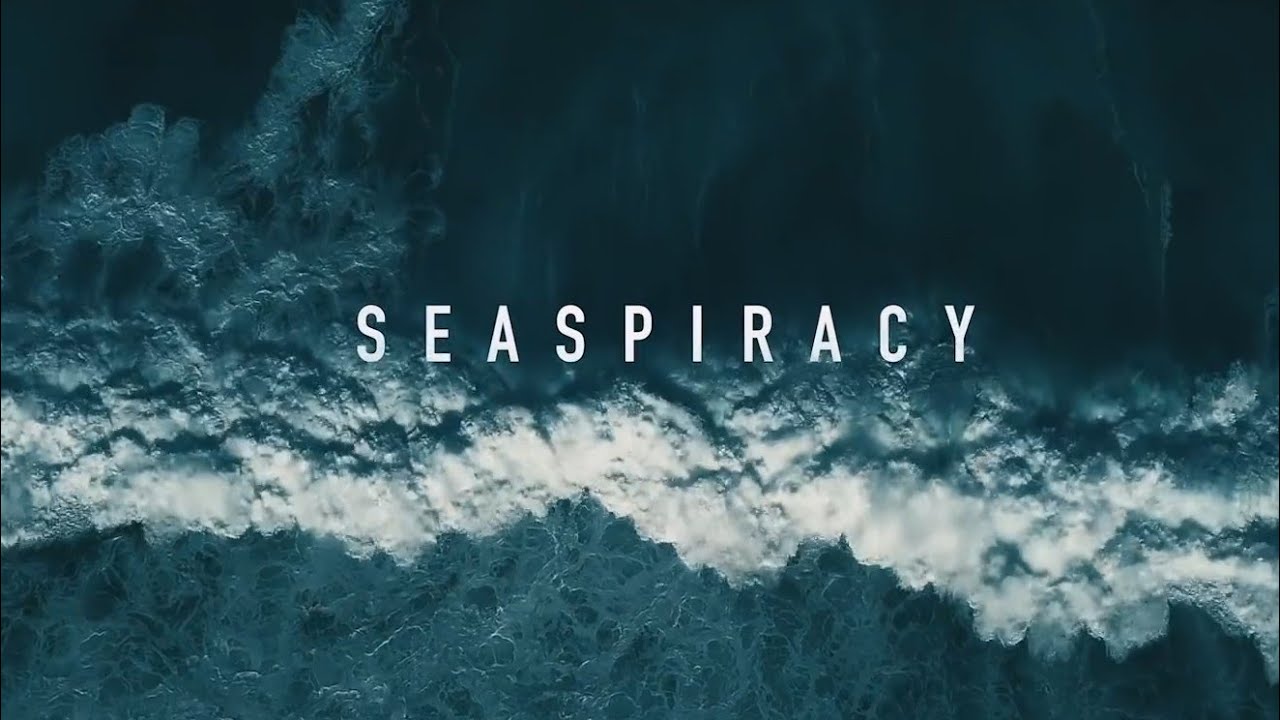‘Seaspiracy: A shocking Indictment of the commercial fishing industry.’1
The Independent, March 2021
Seaspiracy is a Netflix Original documentary following filmmaker Ali Tabrizi as he examines the methods of the worldwide commercial sea fishing industry. Through uncovering corrupt and damaging practices, from dolphin slaughter to species endangerment, the environmental impact of human activities in our oceans are heavily criticised. Tabrizi examines the implications of microplastics, dolphin hunting, whaling, the falsity of ‘dolphin-safe’ tuna and bycatch to create an emotionally weighted scrutiny of human-animal relations within marine ecosystems. The film ultimately advocates for an end to commercialised fishing practices – starting with a change in consumer attitudes towards seafood which is not as sustainable as we thought it to be. Through discussing the climate crisis, along with other lesser-known ideologies such as the debate as to whether fish are sentient, the documentary adopts a polemical approach designed to shock and educate. As a viewer, we are confronted with graphic cinematic imagery which both emphasises how important and beautiful marine life is whilst condemning the harmful human activity imposed on innocent species and their ecosystem.
Tabrizi offers an engaging take on the documentary genre, sharing the filming process and challenges encountered along the way. This fragmented style of filming, flicking between the subject matter and his pursuit of knowledge, reflects the obstacles he confronts when interviewing hostile commercial fishing and environmental organisations who have yet to successfully define or deploy sustainable alternatives. Breaking the fourth wall of the narrative to speak directly to the viewer and advocate his message creates a sense of intimacy that engages the audience, aligning its success with many other works of ecocentric filmmaking. Whilst many critics have praised it for its call for ocean conservation, its polemical nature has also been met with negative criticism with some viewers claiming its approach and presentation appears ‘polarising’ or ‘one-sided.’3 Moreover, this conservationist approach certainly begins through an anthropocentric lens – with the first half undeniably concerning the future health of humanity as opposed to ocean life. Nevertheless, Tabrizi creates a compelling narrative weaved by combining elements of investigative journalism with personal stories to present marine animals in a new light. Its fast-paced editing with quick cuts and a range of dynamic editing techniques maintain the film’s flow, engage viewers and emphasise the impact of the presented information. Visually striking imagery underscores the environmental message throughout which is emphasised in scenes depicting marine life, ocean ecosystems and the consequences of certain fishing practices which create a visceral connection with the viewer. Mixed forms of media to present animals throughout the film adds a layer of complexity when analysing the ocean debate – drawing attention to the interplay between falsity and authenticity in the media and what adaptations of facts can be trusted or not. The use of interviews and testimonials, along with original footage documents the involvement of experts, activists, and other individuals. These first hand accounts provide depth and credibility to the documentary’s exploration of environmental exploitation. Integrating live-action and animation within the documentary allows Tabrizi to confront difficult topics whilst maintaining sensitivity to the trauma discussed. Animation also creatively visualises vocalised facts and statistics which give his narration gravitas. Use of pathos and deliberate aesthetic decisions emphasise a level of manipulation to his fact telling, as the emotional weight of his words clearly suggest a manipulation of viewers’ judgement – the documentary becomes just as much a form of art as a form of advocacy. Music and mise-en-scène are likewise important aspects which Tabrizi deploys in particular ways to prompt certain reactions from the viewer – this is especially poignant when depicting the bodies of animals whether they are dead or alive.
“In a world concerned with carbon and climate change, protecting these animals means protecting the entire planet… if dolphins and whales die the ocean dies and if the ocean dies so do we.”4
Seaspiracy, March 2021
Just two minutes in, Tabrizi outlines the first major issue impacting marine animals: the prevalence of single use plastics within consumerist culture and how plastic pollution in our oceans is causing detrimental consequences. As such, human-animal relations are presented as overwhelmingly negative, with human negligence being exposed for interfering with and degrading innocent marine life. The music shifts from soft and light-hearted guitar, pausing in brief silence, before a more ominous and brooding soundtrack is introduced. A series of short shots displaying the graphic reality of beached whales due to marine plastic begin to ‘litter’ the screen. News article headlines plaster across the shots as audio clips of reporters detailing such incidents reinforce the text. As the music crescendos, the shots become shorter and are cut together quicker as the reporters’ voices increasingly overlap – mimicking the chaotic pattern of repeating events and accentuating the overwhelming impact humanity is having on marine creatures. This is a stark juxtaposition to the “Romantic”5 images of schooling fish and breaching whales featured just moments before. The imagery of the dead whales undeniably creates the ‘shock-factor’ the director was intending as it viscerally highlights the consequences of human activity. Refusing to apply a softer lens, Tabrizi ultimately confronts viewers with the consequences of mainstream society’s actions, in turn, jolting viewers into reconsidering their own habits and improving the relationship between humanity and marine life.
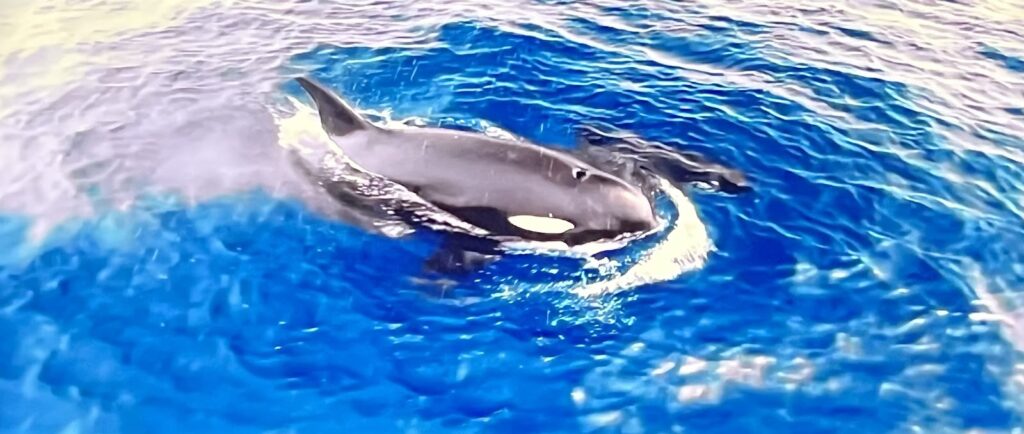
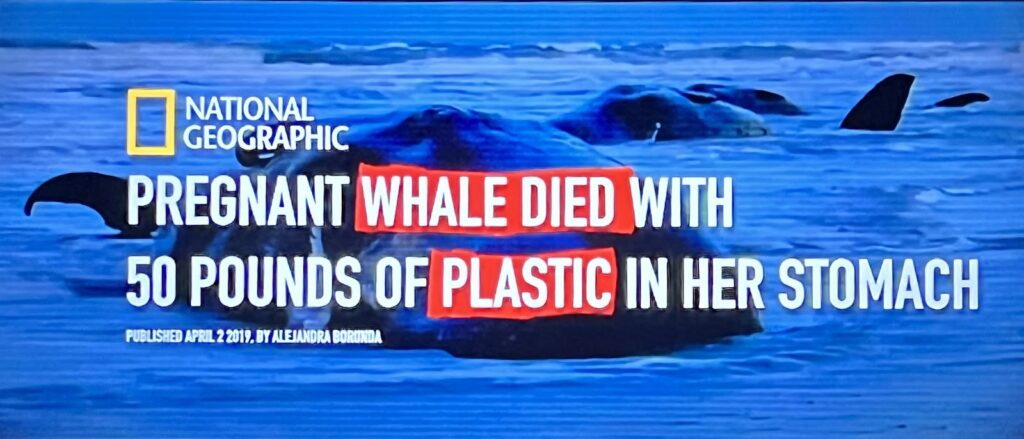
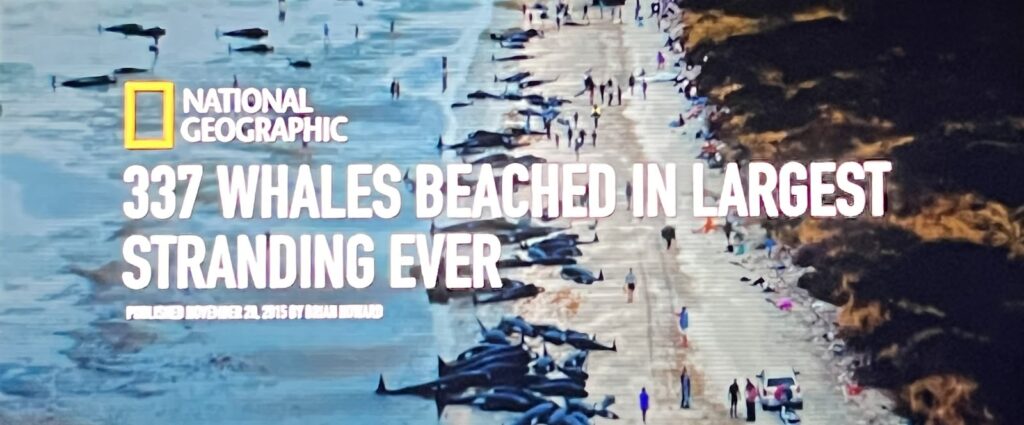
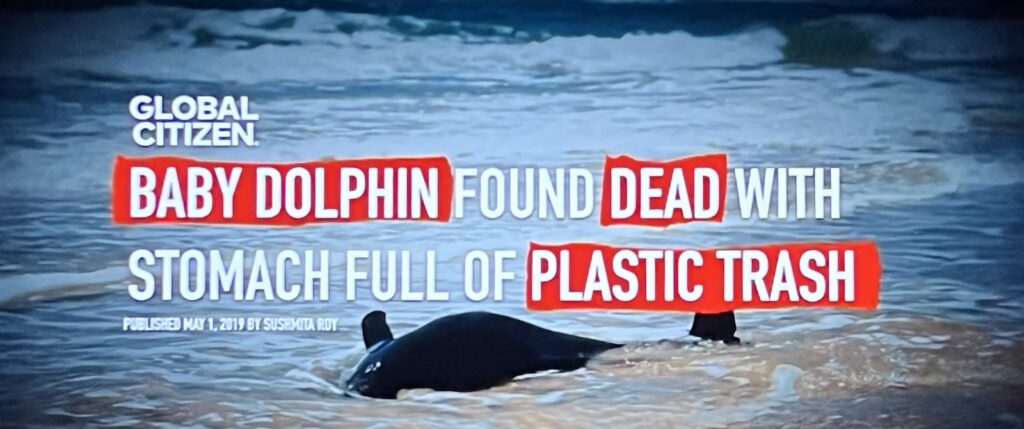
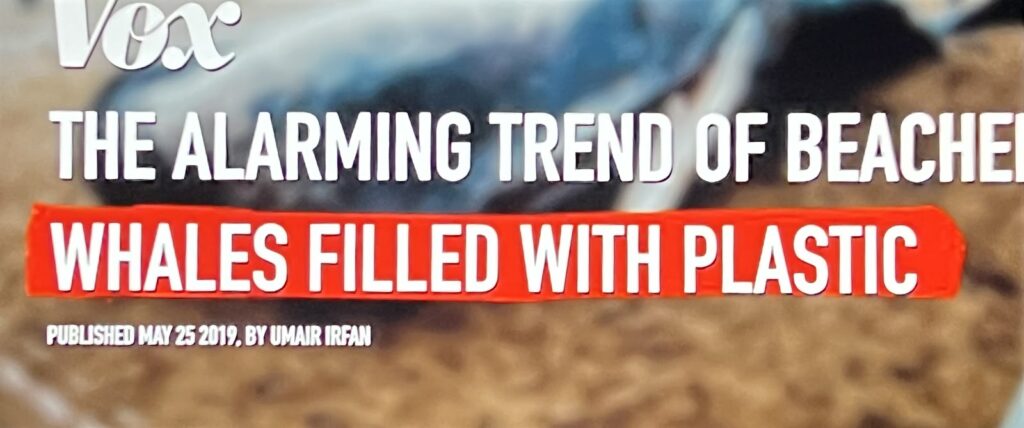
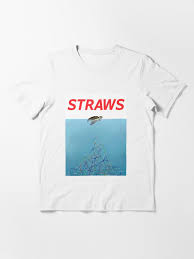
A following scene where Tabrizi is seen to be wearing a “Straws”9 Jaws t-shirt gestures to an increasing interest in marine animal well being perpetuated by the media. The symbol of the Turtle in the media as a means of discouraging the use of straws and other single use plastic has become an increasingly popular trend. The image of the turtle therefore as an illustration has become a tool for propaganda and advocacy for the preservation of marine wildlife by opting for more sustainable ways of living. This suggests a growing interest in improving the relationship between human and marine animals. The representation of marine animals as victims of human activity reinforces the notion of Man as being superior to animal life. This archaic attitude however perpetuates degrading practices that eventually impact upon human life. Tabrizi emphasises that the relationship between humans and animals are mutually dependent, with humanity relying on the oceans, whose health is maintained by marine life, as carbon sinks, climate regulators and oxygen providers. This however reinforces an undeniably anthropocentric way of regarding marine life, with any interest in preserving marine species being for the benefit of humanity as opposed to the animals themselves. Additionally, protests such as ‘Save the Turtles’10 are often ephemeral, raising awareness but not solving the destructive hierarchical relationship between Man and animals.
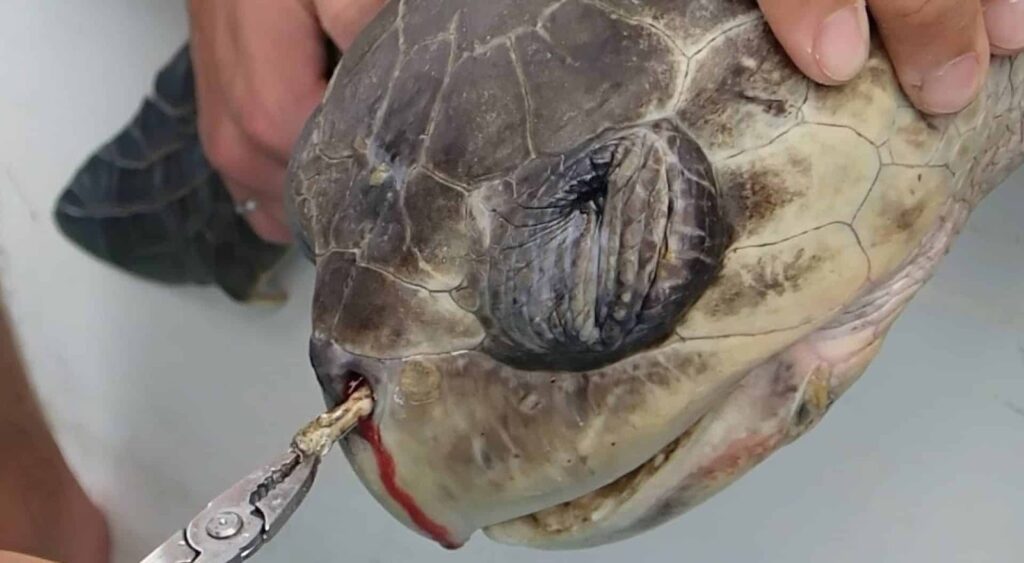
“Can sustainable seafood even exist?”12
Seaspiracy, March 2021

One sector of the fishing industry which the documentary addresses is the $42 billion Tuna section with its elusive protective measures in place to ‘eliminate’ bycatch. This highlights the exploitative nature of human-animal relations with fish being reduced to their value as food and the unintentional suffering of dolphins becoming synonymous with fishing. An animated scene declaring the remarkable strength and speed of Tuna elevates their prowess amongst marine ecosystems. Contrasting this image to following shots of forklifts hoisting tuna from vessels to be lined up in a macabre display creates a harrowing atmosphere that accentuates the scale of the tuna industry which has decimated bluefin tuna populations – classifying them as endangered.
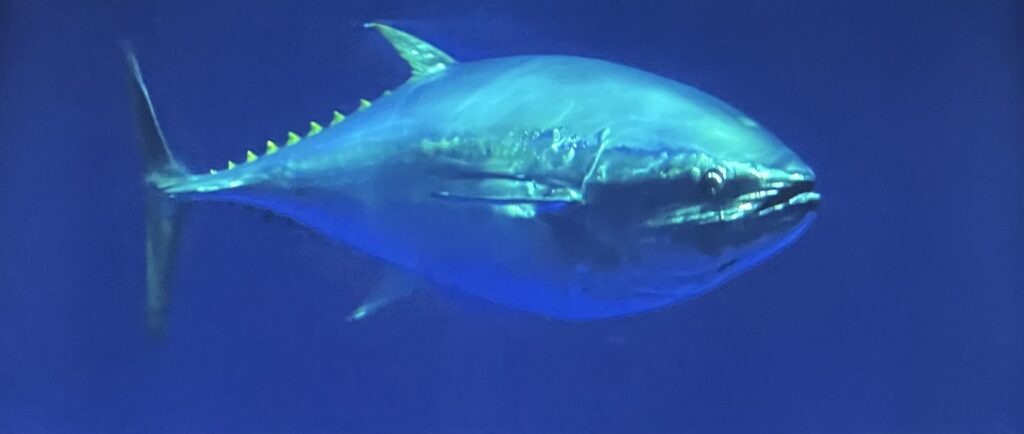
Along with the sheer scale of the tuna industry, is the scale of bycatch due to large commercial fishing vessels’ expansive nets. Shots showing sharks being carelessly thrown overboard, with rope still attached and no guarantee of survival, demonstrates the lack of care many commercial fishing vessels have for prohibited species. Dolphin-safe tuna organisations play an interesting role in maintaining public ignorance to the bycatch problem. Instead of offering a guaranteed solution – ensuring there are no dolphin “accidentally take(n)”15 in the fishing practices they vouch for, the documentary uncovers a history of corruption, bribery and exploitation, where it is clear that consumers are being misled about the authenticity of the eco credentials of their tuna. This suggests there is very little respect for the wellbeing of dolphins from the large commercialised companies. The use of voice-over from participant interviews plays an important role here, allowing Tabrizi to convey the ignorance and irony of key players within the fishing industry whilst providing context to the overlapping footage of fishing vessels and markets.
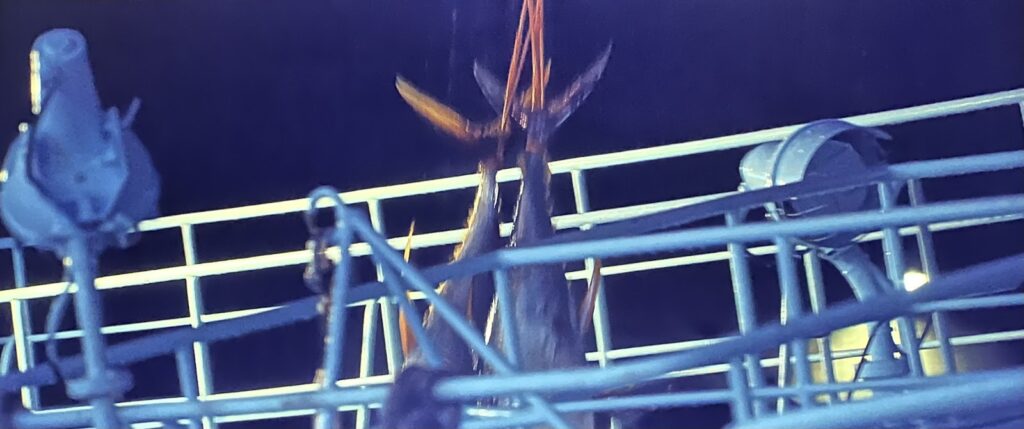
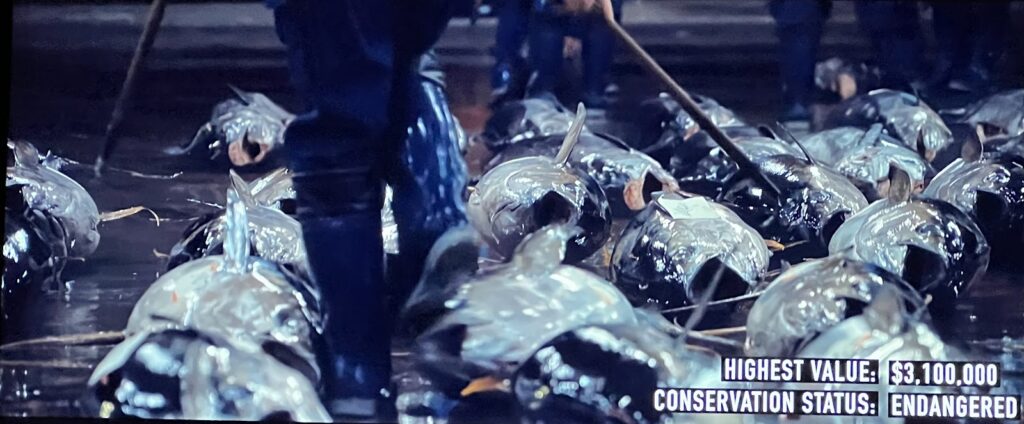
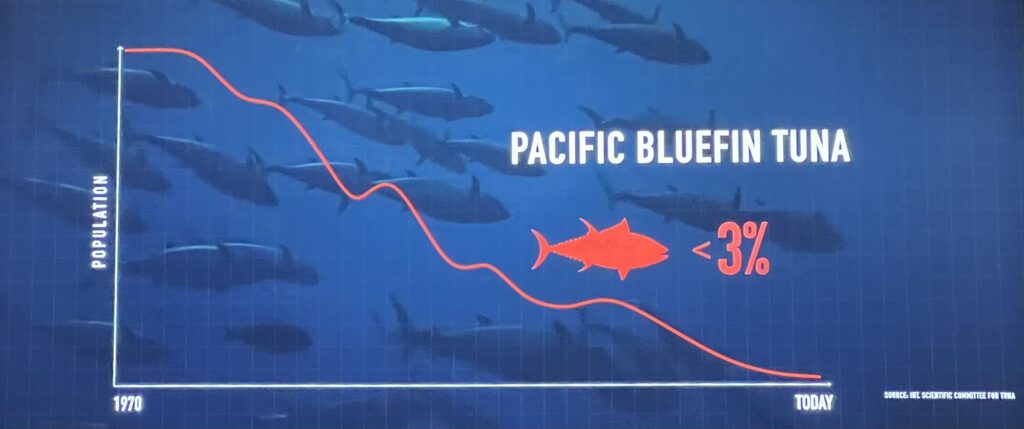
This industrial-scale tuna fishing scene is contrasted to whaling practices in the Faroe Islands. The mise-en-scène here is crucial to creating the emotional impact that truly conveys the plight of marine species. Water tainted with bright red blood, graphic lacerations to the whales’ bodies and ominous grey sky all create the sombre atmosphere which evokes a deep sadness. Watching the physical slaughter and mass culling of such highlight intelligent animals up close, in close-up shots and unknown POV shots, even on a much smaller scale still creates a sadness towards such practices regardless of the sustainability. The soundtrack here, with swelling music emphasising the diegetic whale sounds of pain, emotionally invests us in the unfolding events.
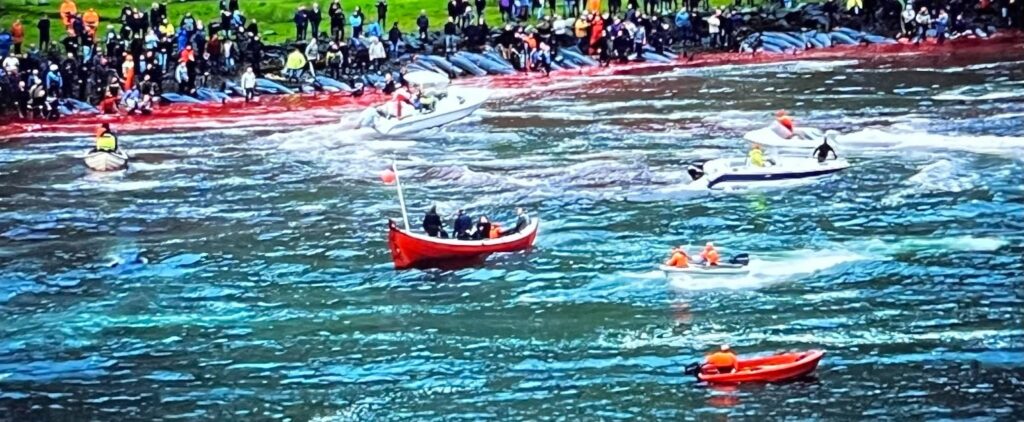
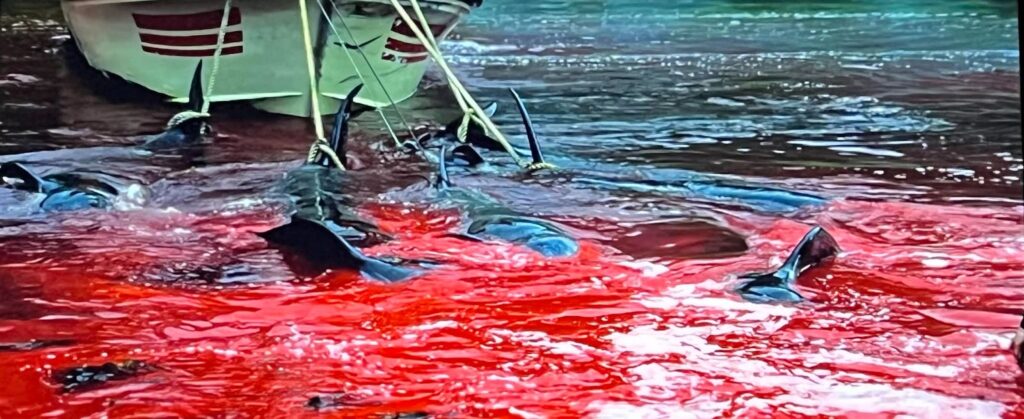
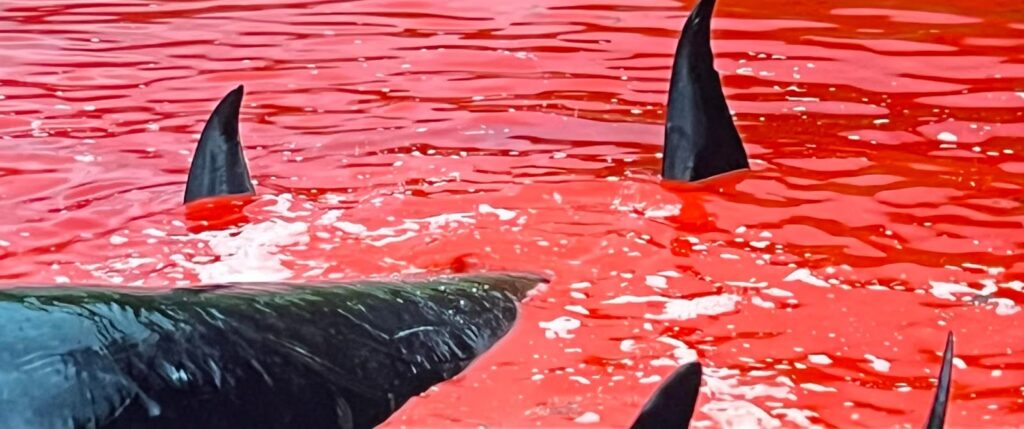
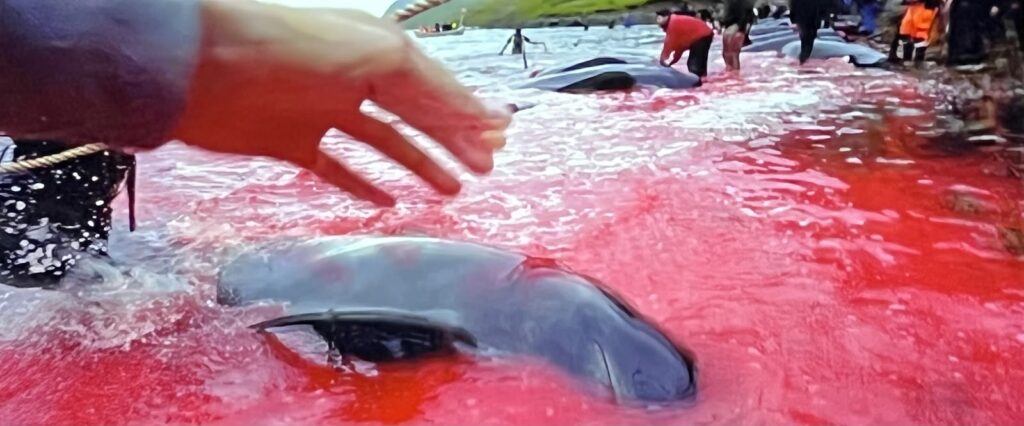
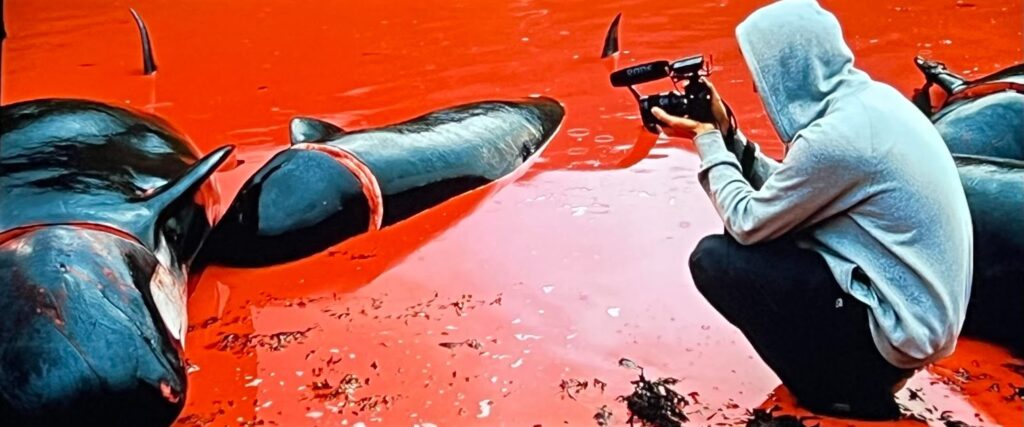
A question however is raised when considering the manipulation of information within the documentary in order to garner Tabrizi’s desired effect. For example, when we view a documentary such as Frozen Planet, we focus on the natural processes within marine ecosystems. Tabrizi neglects to include these natural processes within his film, choosing to instead vilify Man.
“The balance of evidence indicates… fish species have the capacity to experience pain” “…they are able to experience fear.”24
Seaspiracy ESFA, March 2021
A particularly interesting way Tabrizi encourages viewers to empathise with the plight of marine life is by dispelling the doubts regarding fish and their ability to feel. He successfully educates, without anthropomorphising the animals, that fish are sentient beings. Cinematic clips of fish swelling in a school accompany this information, providing a beautiful visual element to the knowledge of them having the capacity to form communities. Fish’s lateral lines which can “sense the most exquisite little movements”25 highlight their sensitivity, prompting viewers to question attitudes towards killing fish in the methodical and “barbaric”26 way that is commonplace commercially. This is perhaps the most ecocentric approach to acknowledging the representation of animals. The relationship between humans and animals therefore is condemned due to ignorant practices that are weakly justified through misinformation.
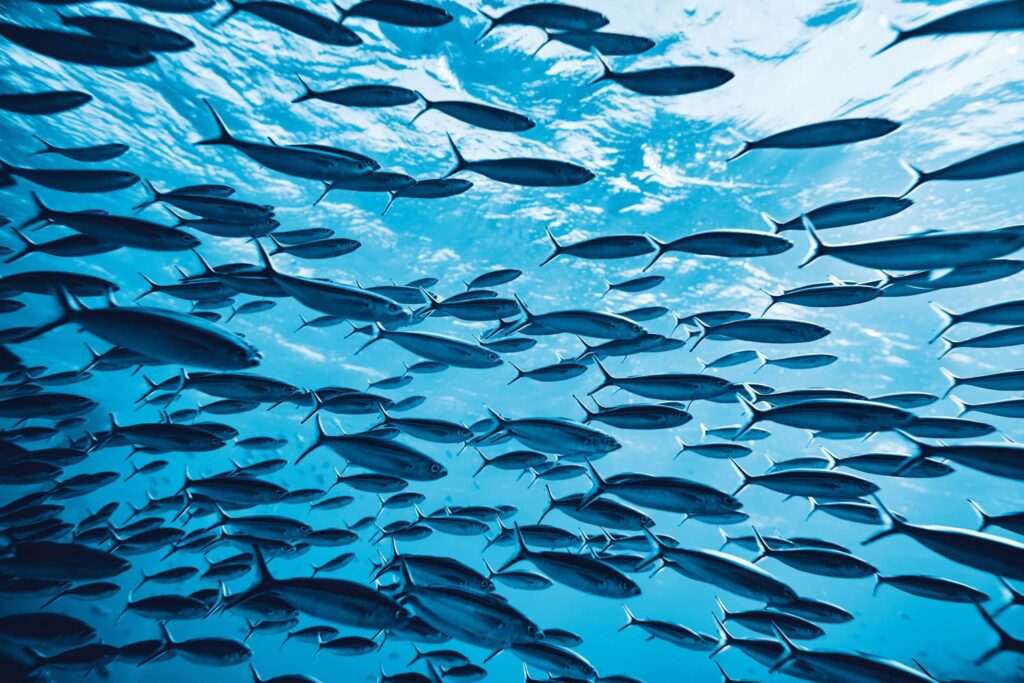
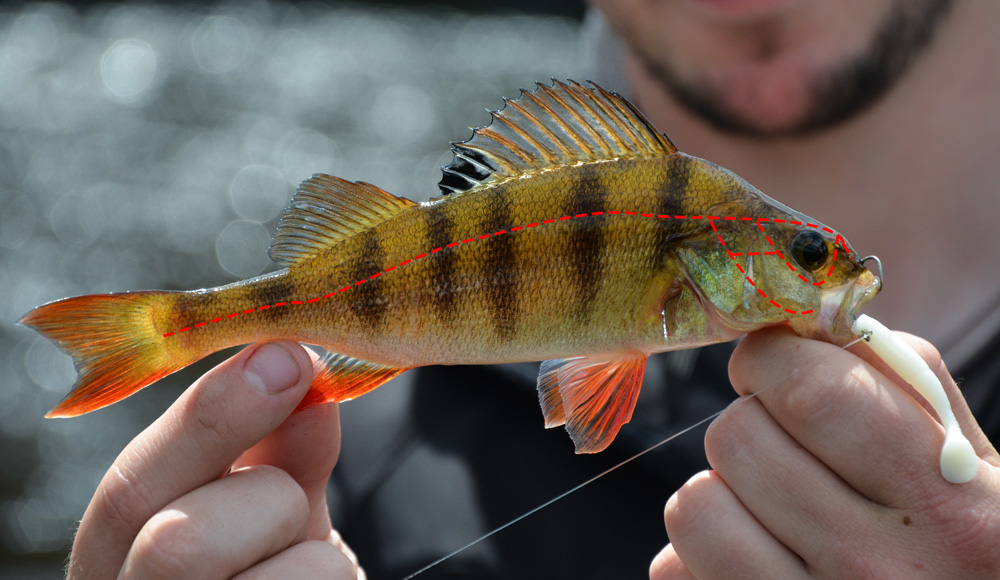
“Man-kind is unable to live on this planet with a dead sea.”29
Seaspiracy, March 2021
Tabrizi elevates his personal approach to the documentary through acknowledging his own childhood naivety relating to the marine park entertainment industry. Employing a series of past and present footage, he explores the relationship between humans and animals in association with entertainment and tourism. Shots of orcas and dolphins performing tricks with an ominous backing track creates a foreboding tone which dismantles the happy facade of a harmless family day out. One particular shot of a Beluga whale with a facial sore highlights the physical implications of life in captivity for such intelligent creatures, whilst another lingering shot of three cetaceans despondent and floating in their tanks highlight their isolation and psychological trauma due to a lack of stimulation within a sterile environment. Animals here are undoubtedly represented as exploited and mistreated, with everything that gives enjoyment in their life being stripped from them.
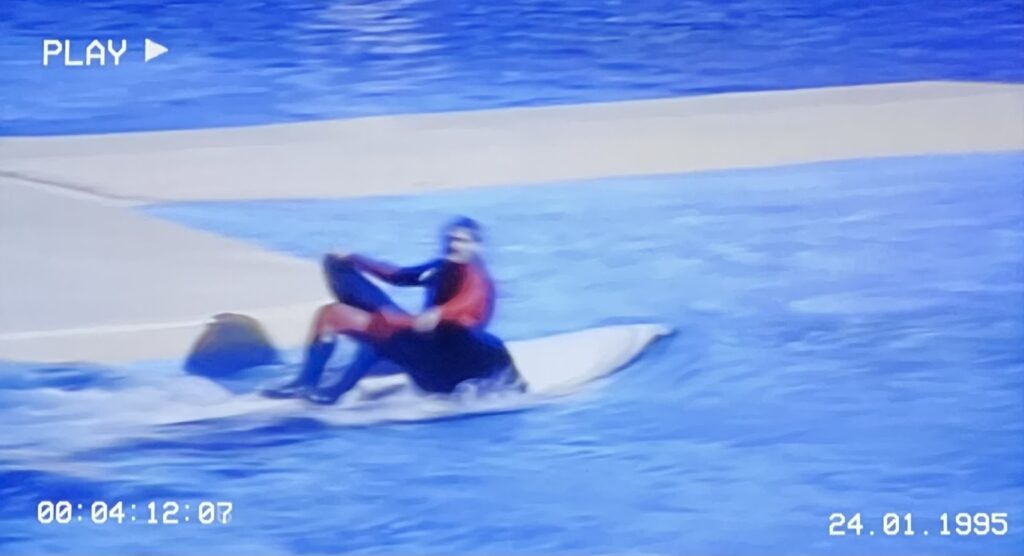
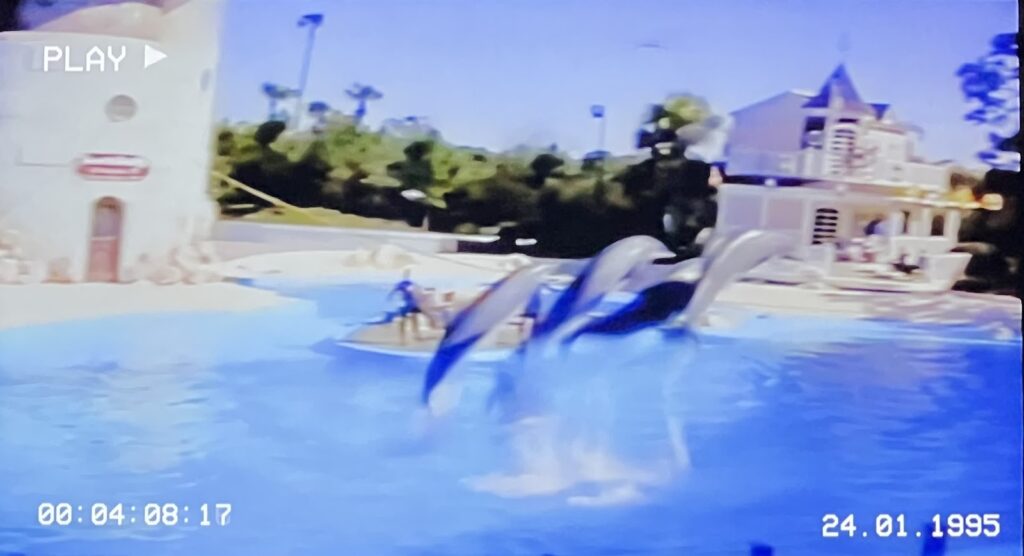
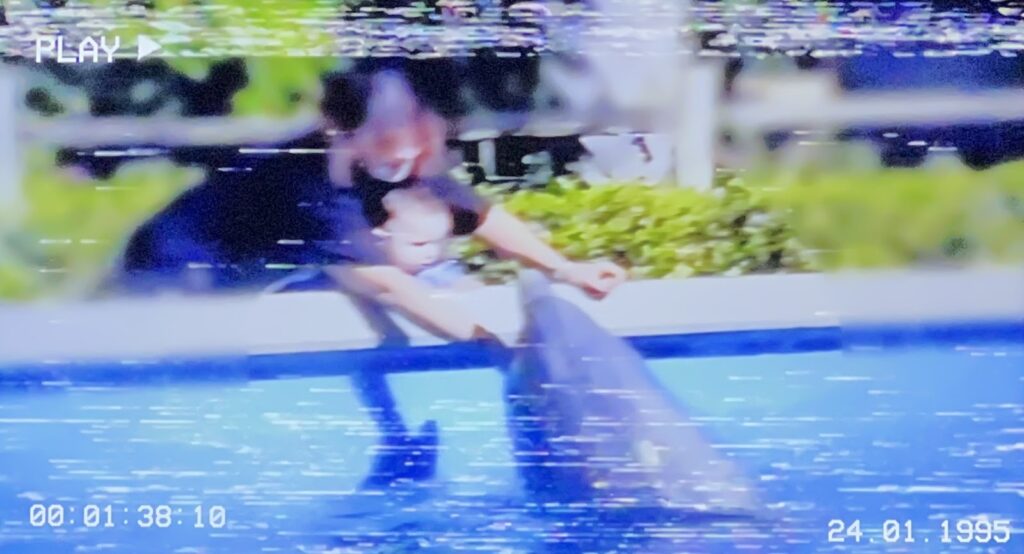
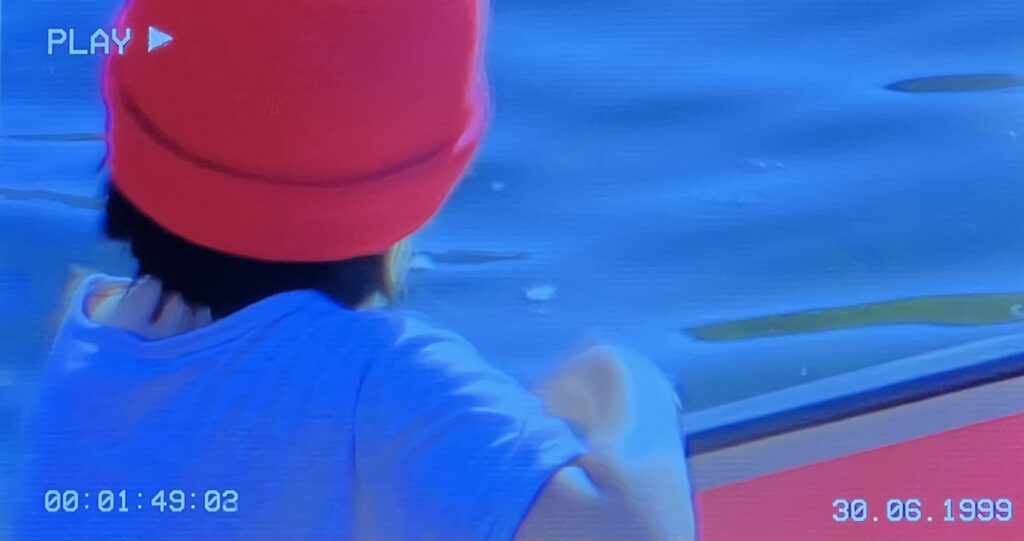
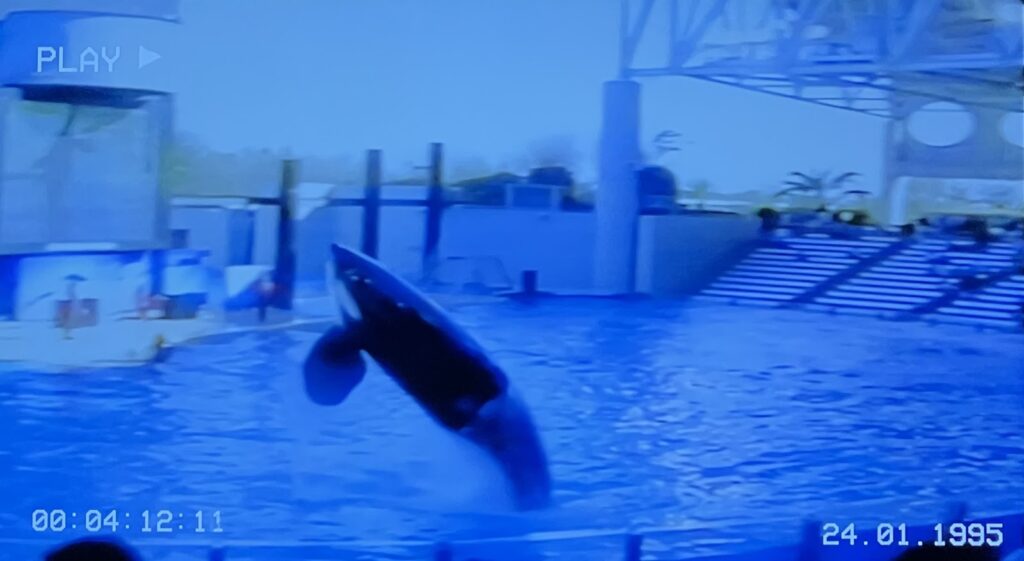
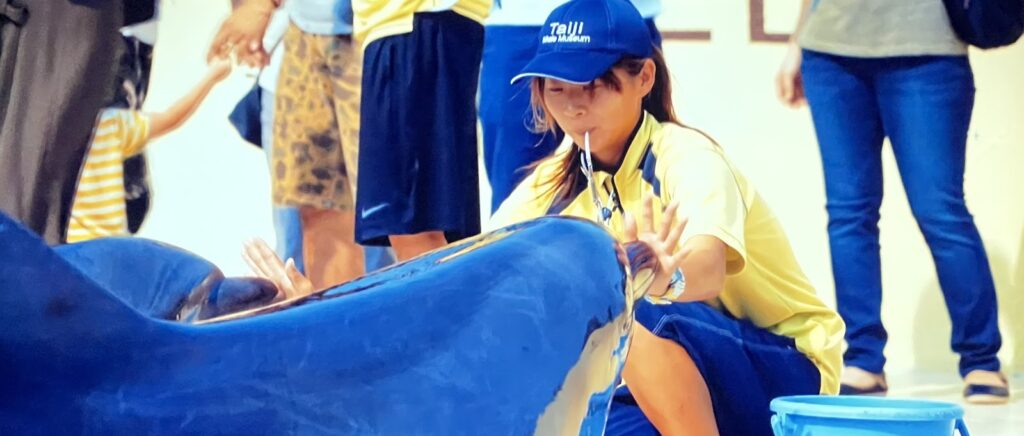
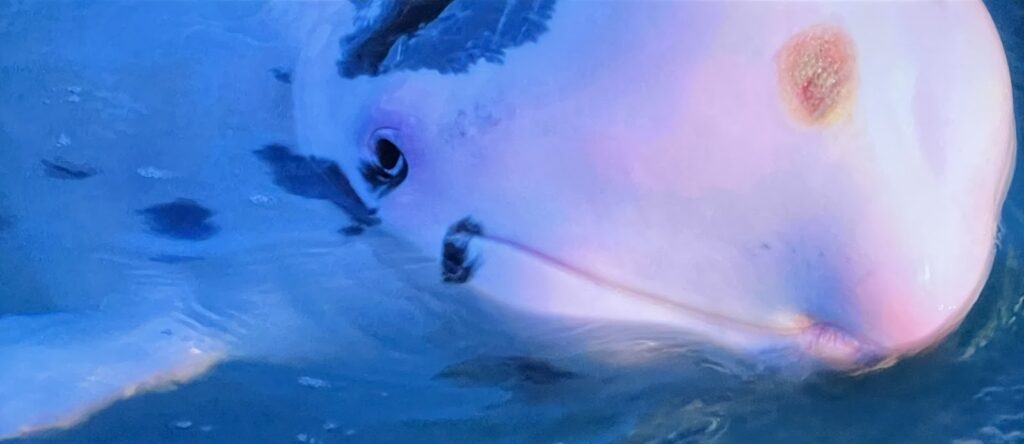
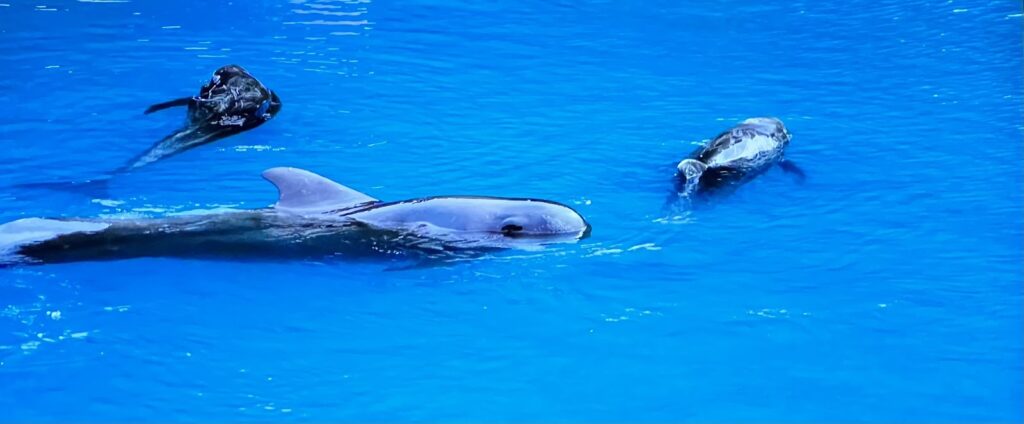
Figure 21: Cetaceans Dejected in their tanks33
Thus, the relationship between humans and animals as a source of entertainment is established as extremely problematic. Not only do these industries lead to the degradation of marine mammal health, they are also exposed as supporting harmful entrapment practices such as the annual dolphin drive in Taiji, Japan. In this scene, a series of close-up shots offer a brief glimpse at the deeply controversial mass killing of dolphins as a method of eliminating competition to the fishing industry and collecting profitable young calves to be sold and trained. The striking imagery of the red water undoubtedly promotes outrage for such practices, encouraging viewers to question their own connection to such an industry.
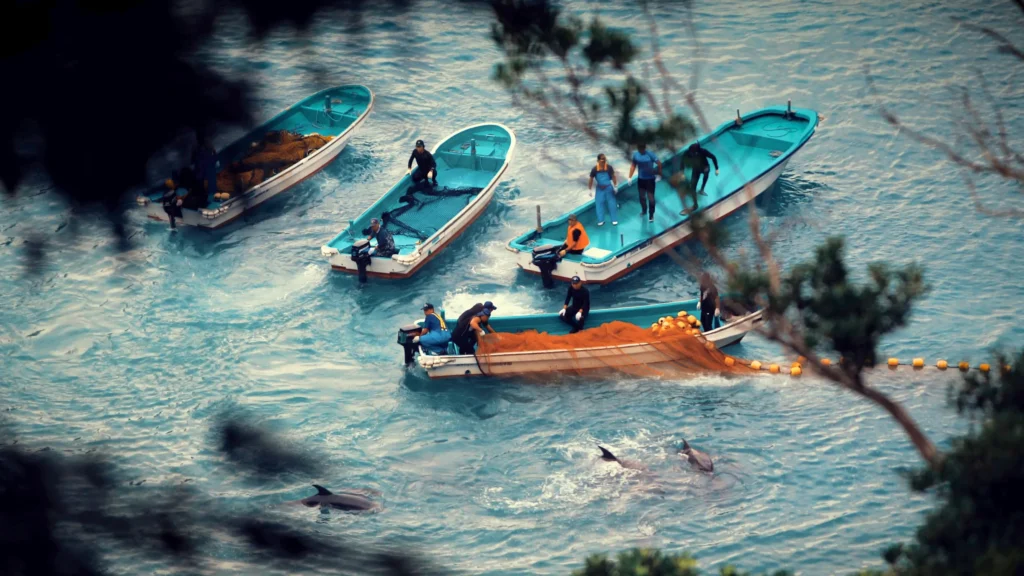
Seaspiracy fundamentally encourages viewers to criticise negative human-animal relationships within marine ecosystems. In doing so, it encourages a reflective response from viewers who become educated on the exploitative connection between human and marine animal life.
Seaspiracy ultimately serves to act as a catalyst for environmental advocacy. Its dramatised approach to the documentary gives the message a sense of urgency synonymous with environmental activism. Its representation of animals in such a bleak and unsettling way reflects human-animal relations as exploitative – with humans taking advantage of marine wildlife for food and entertainment whilst also dominating species populations through ‘culling’ as a form of ‘pest control.’ The film expresses parallels with a number of environmental documentaries such as Gabriela Cowperthwaite’s Blackfish which sheds light on the consequences of keeping Orcas in captivity both on humans and the individuals.
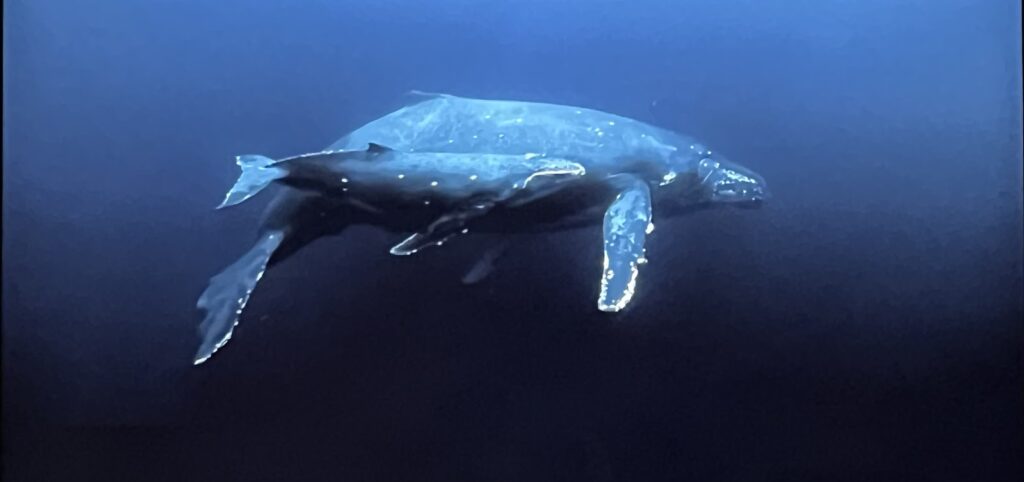
Bibliography:
Primary Sources:
Seaspiracy, Ali Tabrizi (Netflix, 2021) <https://www.netflix.com/gb/title/81014008> [accessed 20 December 2023]
Secondary Sources:
BBC Earth, ‘Incredible Orca Hunt | Frozen Planet II | BBC Earth,’ Youtube, 2022 <https://www.youtube.com/watch?v=fs8ZveNZQ8g> [accessed 20 December 2023]
Brazier, Bill, ‘The Lateral Line,’ Off the scale angling, 2015 <https://www.offthescaleangling.ie/the-science-bit/lateral-line-fish/> [accessed 10 January 2024]
Cripps, Charlotte, ‘Seaspiracy review: A shocking indictment of the commercial fishing industry,’ Independent, 2021 <https://www.independent.co.uk/arts-entertainment/films/reviews/seaspiracy-review-netflix-documentary-fishing-b1824324.html> [accessed 12 January 2024]
Duong, Tiffany, ‘Netlix’s ‘Seaspiracy’: viewers react to commercial fishing industry exposé,’ EcoWatch, 2021 <https://www.ecowatch.com/commercial-fishing-netflix-documentary-2651331648.html> [accessed 12 December 2024]
Lockhart, Keely, ‘Plastic straw removed from turtle’s nose by marine biologist in heartbreaking video,’ The Telegraph, 2015 <https://www.telegraph.co.uk/news/2016/03/22/plastic-straw-removed-from-turtles-nose-by-marine-biologists-in/> [accessed 12 January 2024]
Netflix, ‘Seaspiracy – Official Trailer – Netflix,’ YouTube, 2021 <https://www.youtube.com/watch?v=1Q5CXN7soQg&t=1s> [accessed 12 December 2023]
NOAA Fisheries, ‘Dolphin-Safe,’ NOAA Fisheries, 2023 <https://www.fisheries.noaa.gov/national/marine-mammal-protection/dolphin-safe> [accessed 12 January 2024]
Red Bubble, ‘Turtle Straws Jaws Classic T-shirt,’ Red Bubble, n.d. <https://www.redbubble.com/i/t-shirt/Turtle-Straws-Jaws-by-Cranmer93/32423287.WFLAH?country_code=GB&gad_source=1&gclid=Cj0KCQiAtaOtBhCwARIsAN_x-3ISNwPVzN-6GS1tVsU-gz_i3yzyzyF0Ofic67uKdc1QuGT-m_2spHkaAkeuEALw_wcB&gclsrc=aw.ds> [accessed 10 January 2024]
Save the Turtles, ‘Our Mission: Direct Protection of Sea Turtles and Their Eggs from Poachers (for over 20 years),’ Save the Turtles, n.d. <https://saveturtles.org/> [accessed 23 December 2023]
Sturley, Benjamin, ‘Murder at Sea,’ Seaspiracy (Original Soundtrack) [download track] (Spotify, 10 January 2024]
Further reading:
Blackfish Zooscope:
Hong, Da Som, ‘Blackfish. Dir. Gabriela Cowperthwaite. Magnolia Pictures. 2013.,’ Zooscope, 2014 <https://zooscope.group.shef.ac.uk/blackfish-full/> [accessed 10 January 2024]
Blackfish Documentary:
Cowperthwaite, Gabriela, Blackfish, Magnolia Pictures, 2013.
Grizzly Man Documentary:
Werner, Herzog, Grizzly Man, Lions Gate Films, 2005.
The Blue Planet: A Natural History of our oceans Book:
Byatt, Andrew, Fothergill, Alastair and Holmes, Martha, The Blue Planet: A Natural History of our oceans (London: BBC Worldwide, 2001),
Article on ecocentrism:
University of Sussex, ‘Ecocentrism in Policy and Law,’ Media, Arts, Humanities Sustainability Educator Toolkit (2023) <https://openpress.sussex.ac.uk/sustainabilityeducatortoolkit/chapter/ecocentrism-in-policy-and-law/> [accessed 9 January 2024]
The Whale Zooscope:
Perlman, Lindsey, ‘The Whale. Dir. Suzanne Chisholm, Michael Parfit. Kinosmith & Paladin. 2011.,’ Zooscope, 2016 <https://zooscope.group.shef.ac.uk/the-whale-dir-suzanne-chisholm-michael-parfit-kinosmith-paladin-2011/> [accessed 9 January 2024]
Dolphin-Safe fisheries information:
NOAA Fisheries, ‘Dolphin-Safe,’ NOAA Fisheries, 2023 <https://www.fisheries.noaa.gov/national/marine-mammal-protection/dolphin-safe> [accessed 12 January 2024]
Seaspiracy IMDb Webpage:
IMDb, ‘Seaspiracy,’ IMDb, 2021 <https://www.imdb.com/title/tt14152756/> [accessed 18 December 2023]
Footnotes:
- Charlotte, Cripps, ‘Seaspiracy review: A shocking indictment of the commercial fishing industry,’ Independent, 2021 <https://www.independent.co.uk/arts-entertainment/films/reviews/seaspiracy-review-netflix-documentary-fishing-b1824324.html> [accessed 12 January 2024] ↩︎
- Netflix, ‘Seaspiracy – Official Trailer – Netflix,’ YouTube, 2021 <https://www.youtube.com/watch?v=1Q5CXN7soQg&t=1s> [accessed 12 December 2023] ↩︎
- Tiffany, Duong, ‘Netlix’s ‘Seaspiracy’: viewers react to commercial fishing industry exposé,’ EcoWatch, 2021 <https://www.ecowatch.com/commercial-fishing-netflix-documentary-2651331648.html> [accessed 12 December 2024] ↩︎
- Seaspiracy, Ali Tabrizi (Netflix, 2021) <https://www.netflix.com/gb/title/81014008> [accessed 20 December 2023] ↩︎
- Seaspiracy, Ali Tabrizi (Netflix, 2021) <https://www.netflix.com/gb/title/81014008> [accessed 20 December 2023] ↩︎
- Seaspiracy, Ali Tabrizi (Netflix, 2021) <https://www.netflix.com/gb/title/81014008> [accessed 20 December 2023] ↩︎
- Seaspiracy, Ali Tabrizi (Netflix, 2021) <https://www.netflix.com/gb/title/81014008> [accessed 20 December 2023] ↩︎
- Red Bubble, ‘Turtle Straws Jaws Classic T-shirt,’ Red Bubble, n.d. <https://www.redbubble.com/i/t-shirt/Turtle-Straws-Jaws-by-Cranmer93/32423287.WFLAH?country_code=GB&gad_source=1&gclid=Cj0KCQiAtaOtBhCwARIsAN_x-3ISNwPVzN-6GS1tVsU-gz_i3yzyzyF0Ofic67uKdc1QuGT-m_2spHkaAkeuEALw_wcB&gclsrc=aw.ds> [accessed 10 January 2024] ↩︎
- Seaspiracy, Ali Tabrizi (Netflix, 2021) <https://www.netflix.com/gb/title/81014008> [accessed 20 December 2023] ↩︎
- Save the Turtles, ‘Our Mission: Direct Protection of Sea Turtles and Their Eggs from Poachers (for over 20 years),’ Save the Turtles, n.d. <https://saveturtles.org/> [accessed 23 December 2023] ↩︎
- Keely Lockhart, ‘Plastic straw removed from turtle’s nose by marine biologist in heartbreaking video,’ The Telegraph, 2015 <https://www.telegraph.co.uk/news/2016/03/22/plastic-straw-removed-from-turtles-nose-by-marine-biologists-in/> [accessed 12 January 2024] ↩︎
- Seaspiracy, Ali Tabrizi (Netflix, 2021) <https://www.netflix.com/gb/title/81014008> [accessed 20 December 2023] ↩︎
- Seaspiracy, Ali Tabrizi (Netflix, 2021) <https://www.netflix.com/gb/title/81014008> [accessed 20 December 2023] ↩︎
- Seaspiracy, Ali Tabrizi (Netflix, 2021) <https://www.netflix.com/gb/title/81014008> [accessed 20 December 2023] ↩︎
- Seaspiracy, Ali Tabrizi (Netflix, 2021) <https://www.netflix.com/gb/title/81014008> [accessed 20 December 2023] ↩︎
- Seaspiracy, Ali Tabrizi (Netflix, 2021) <https://www.netflix.com/gb/title/81014008> [accessed 20 December 2023] ↩︎
- Seaspiracy, Ali Tabrizi (Netflix, 2021) <https://www.netflix.com/gb/title/81014008> [accessed 20 December 2023] ↩︎
- Seaspiracy, Ali Tabrizi (Netflix, 2021) <https://www.netflix.com/gb/title/81014008> [accessed 20 December 2023] ↩︎
- Benjamin Sturley, ‘Murder at Sea,’ Seaspiracy (Original Soundtrack) [download track] (Spotify, 10 January 2024] ↩︎
- Seaspiracy, Ali Tabrizi (Netflix, 2021) <https://www.netflix.com/gb/title/81014008> [accessed 20 December 2023] ↩︎
- Seaspiracy, Ali Tabrizi (Netflix, 2021) <https://www.netflix.com/gb/title/81014008> [accessed 20 December 2023] ↩︎
- Seaspiracy, Ali Tabrizi (Netflix, 2021) <https://www.netflix.com/gb/title/81014008> [accessed 20 December 2023] ↩︎
- BBC Earth, ‘Incredible Orca Hunt | Frozen Planet II | BBC Earth,’ Youtube, 2022 <https://www.youtube.com/watch?v=fs8ZveNZQ8g> [accessed 20 December 2023] ↩︎
- Seaspiracy, Ali Tabrizi (Netflix, 2021) <https://www.netflix.com/gb/title/81014008> [accessed 20 December 2023] ↩︎
- Seaspiracy, Ali Tabrizi (Netflix, 2021) <https://www.netflix.com/gb/title/81014008> [accessed 20 December 2023] ↩︎
- Seaspiracy, Ali Tabrizi (Netflix, 2021) <https://www.netflix.com/gb/title/81014008> [accessed 20 December 2023] ↩︎
- Seaspiracy, Ali Tabrizi (Netflix, 2021) <https://www.netflix.com/gb/title/81014008> [accessed 20 December 2023] ↩︎
- Bill, Brazier, ‘The Lateral Line,’ Off the scale angling, 2015 <https://www.offthescaleangling.ie/the-science-bit/lateral-line-fish/> [accessed 10 January 2024] ↩︎
- Seaspiracy, Ali Tabrizi (Netflix, 2021) <https://www.netflix.com/gb/title/81014008> [accessed 20 December 2023] ↩︎
- Seaspiracy, Ali Tabrizi (Netflix, 2021) <https://www.netflix.com/gb/title/81014008> [accessed 20 December 2023] ↩︎
- Seaspiracy, Ali Tabrizi (Netflix, 2021) <https://www.netflix.com/gb/title/81014008> [accessed 20 December 2023] ↩︎
- Seaspiracy, Ali Tabrizi (Netflix, 2021) <https://www.netflix.com/gb/title/81014008> [accessed 20 December 2023] ↩︎
- Seaspiracy, Ali Tabrizi (Netflix, 2021) <https://www.netflix.com/gb/title/81014008> [accessed 20 December 2023] ↩︎
- Seaspiracy, Ali Tabrizi (Netflix, 2021) <https://www.netflix.com/gb/title/81014008> [accessed 20 December 2023] ↩︎
- Seaspiracy, Ali Tabrizi (Netflix, 2021) <https://www.netflix.com/gb/title/81014008> [accessed 20 December 2023] ↩︎
